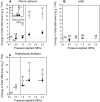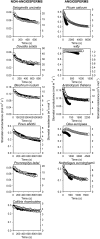Linking Turgor with ABA Biosynthesis: Implications for Stomatal Responses to Vapor Pressure Deficit across Land Plants
- PMID: 27208264
- PMCID: PMC4936570
- DOI: 10.1104/pp.16.00380
Linking Turgor with ABA Biosynthesis: Implications for Stomatal Responses to Vapor Pressure Deficit across Land Plants
Abstract
Stomatal responses to changes in vapor pressure deficit (VPD) constitute the predominant form of daytime gas-exchange regulation in plants. Stomatal closure in response to increased VPD is driven by the rapid up-regulation of foliar abscisic acid (ABA) biosynthesis and ABA levels in angiosperms; however, very little is known about the physiological trigger for this increase in ABA biosynthesis at increased VPD Using a novel method of modifying leaf cell turgor by the application of external pressures, we test whether changes in turgor pressure can trigger increases in foliar ABA levels over 20 min, a period of time most relevant to the stomatal response to VPD We found in angiosperm species that the biosynthesis of ABA was triggered by reductions in leaf turgor, and in two species tested, that a higher sensitivity of ABA synthesis to leaf turgor corresponded with a higher stomatal sensitivity to VPD In contrast, representative species from nonflowering plant lineages did not show a rapid turgor-triggered increase in foliar ABA levels, which is consistent with previous studies demonstrating passive stomatal responses to changes in VPD in these lineages. Our method provides a new tool for characterizing the response of stomata to water availability.
© 2016 American Society of Plant Biologists. All Rights Reserved.
Figures




References
-
- Appleby RF, Davies WJ (1983) A possible evaporation site in the guard cell wall and the influence of leaf structure on the humidity response by stomata of woody plants. Oecologia 56: 30–40 - PubMed
-
- Bauer H, Ache P, Lautner S, Fromm J, Hartung W, Al-Rasheid KA, Sonnewald S, Sonnewald U, Kneitz S, Lachmann N, et al. (2013) The stomatal response to reduced relative humidity requires guard cell-autonomous ABA synthesis. Curr Biol 23: 53–57 - PubMed
-
- Bauerle WL, Whitlow TH, Setter TL, Vermeylen FM (2004) Abscisic acid synthesis in Acer rubrum L. leaves—a vapor-pressure-deficit-mediated response. J Am Soc Hortic Sci 129: 182–187
Publication types
MeSH terms
Substances
LinkOut - more resources
Full Text Sources
Other Literature Sources

